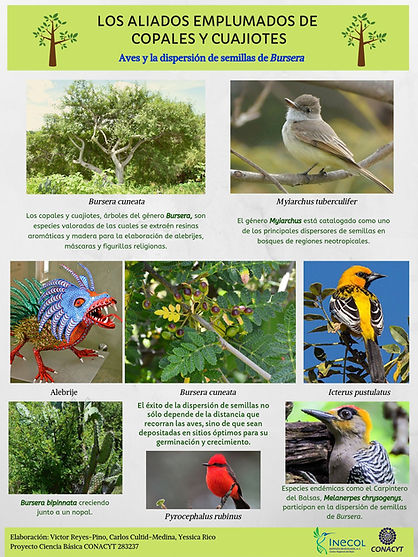Red de Diversidad Biológica del Occidente Mexicano
Landscape genetics of Bursera cuneata in the Bajío Region
Habitat loss and fragmentation of the Tropical Dry Forest (TDF) in Mexico are high due to urbanization, agriculture, and cattle raising. Many typical TDF tree species, such as Bursera populations are in decline and increasingly fragmented . Burseras are important sources of wood in rural communities and have a high potential for habitat restoration. Despite their importance in the TDF there is scarce information on their genetic diversity and gene flow. This project aims to understand the determinants of spatial patterns of gene flow and genetic diversity in Bursera cuneata, an important species of the TDF in the Bajío Region in Mexico. This project has important conservation implications.
Related paper: Rico (2017) New Forest
_JPG.jpg)

Interspecific hybridization among Bursera species (Bullockia section)
Hybridization among closely related species is a common phenomenon in plants, and it is an important process driving adaptation and species diversification. Hybrid zones provide the opportunity to understand the mechanisms of reproductive isolation, genomic divergence in the presence of gene flow, and local adaptation. Moreover, hybridization has important consequences on species biodiversity under climate change. This project aims to investigate the process of interspecific hybridization among three Bursera species of the Bullockia section through SNPs analysis to identify the potential of adaptive divergence despite gene flow. Moreover, we will evaluate hybrid vigor (viability of pollen and seeds) relative to parental species, and the importance of frugivore seed dispersal within a hybrid zone.
Collaborators: Andrés Lira Noriega (INECOL), Antonio González Rodríguez (IIES UNAM)
Related paper: Quintero-Melecio et al. (2021)
Conservation genetics of Magnolia species
Magnolias are characteristic tree species of the Tropical Montane Cloud Forest (TMCF) in Mexico, an ecosystem that is highly threatened by habitat fragmentation and climate change. They are valued species used for timber, medicinal properties, and as ornamental trees in public gardens. Unfortunately, in Mexico, many endemic Magnolia species are vulnerable to extinction due to their low population sizes and restricted distribution. We are currently investigating the population genetics of M. schiedeana, M. pedrazae, and M. iltisiana (Magnolia section) to assess patterns of genetic diversity and structure among fragmented populations and to better inform conservation efforts.
Collaborators: Jessica Pérez Alquicira (UDG), Miguel Ángel Muñiz Castro (UDG) (Magnolia iltisiana project)
Related paper: Rico Y. & Gutiérrez-Becerril B.A. (2019) GENETICA


Systematics and Population genetics of Salvia species in Western Mexico
Salvia is a diverse genus of herbaceous plants in Mexico, comprising approx. 300 species, many of which are endemic to the country (88%). The vast majority of species diversity is found in mountainous regions, mainly in the central and southern parts of Mexico. Despite the importance of the genera, there are no molecular studies based on highly polymorphic markers across Mexican Salvia species, which may help to elucidate the relationship between closely related species, the population history of endemic zones, and patterns of genetic diversity and structure among populations.
Collaborators: Brenda Bedolla García (INECOL); Sergio Zamudio Ruíz
Functional connectivity of aquatic plants in Western Mexico
Functional connectivity is still poorly understood for aquatic plants in freshwater wetlands despite of being one of the most threatened ecosystems worldwide. The geographically isolated wetlands of Western Mexico (Michoacán, Jalisco y Guanajuato) are species-rich habitats that are increasingly threatened by land degradation. In this project, we will investigate spatial patterns of genetic diversity for two sedge species (Schoenoplectus californicus and S. acutus) to examine the determinants of gene flow at the landscape scale.
Collaborators: Tatiana Lobato-de Magalhanes, Universidad Autónoma de Querétaro.

Frugivore seed dispersal and floral visitors interactions among Bursera species and their hybrids in the Bajio region
Seed and pollen dispersal are key processes maintaining gene flow and recruitment among plant populations. In many tropical forest species, such processes highly depend on biotic vectors, which dispersal behavior likely changes under degraded and fragmented landscapes. Burseras are key elements of the tropical dry forest in Mexico; floral and fruit production is usually abundant during the rainy season, thus supporting a large variety of frugivore birds and insect floral visitors. However, these processes have been poorly studied in most Bursera species and highly human-transformed landscapes such as the Bajio region. This project aims to identify the networks of floral visitors and frugivore bird species of three Bursera species and their putative hybrids in forest patches within a hybrid zone. Also, we would evaluate the effectiveness of bird-dispersal vectors and their link with spatial patterns of gene flow for the Bursera species and their putative hybrids.
Collaborators: Carlos A. Cultid Medina (INECOL)
